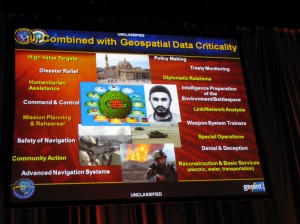
On April 4, 2012, I spoke on a panel discussion on National Security, Secrecy and Surveillance in New York City. The event (you can watch a video of it here) was sponsored by the Open Society Foundations and the Government Accountability Project, and moderated by Steven Aftergood, the renowned editor of Secrecy News for the Federation of American Scientists. Besides myself, the speakers were Thomas Drake, the courageous former intelligence officer who blew the whistle on National Security Agency/contractor corruption during the Bush administration and was wrongly prosecuted by the Obama administration as a result; his equally courageous attorney, Jessylyn Radek , who is a whistle-blower herself for exposing the barbaric treatment of the so-called “American Taliban” John Walker Lindh in the days after 9/11; and Jameel Jaffer of the ACLU, who has participated in some of the most important national security litigation of the past ten years.
The format was informal; Aftergood posed a series of questions to each panelist, giving us a few minutes to respond, and then posed a series of follow-up queries. After that, the audience got to ask its own questions, and at the end we all gave some final thoughts (the entire event is now available on video at the OSF website).
For me, it was a tremendous honor to speak about my special area of expertise, intelligence contracting, with people who have spent much of the last decade fighting the threat to democracy posed by our national surveillance state. I had prepared a five-minute talk, but what I had written didn’t fit into the Q&A format. So I thought readers of my book SPIES FOR HIRE and my many followers on Twitter would be interested in the notes I made in preparation, and I present them below. I started by talking about the NSA’s Trailblazer program, a $4 billion corporate boondoggle that Tom Drake, as an NSA whistle-blower, had sought to expose as a massive waste of resources and a threat to our democratic rights. Here’s what I said:
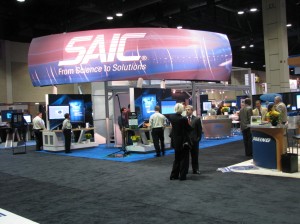 Trailblazer is highly symbolic of the folly of contracting. It was an enormous, wasteful project that made a lot of people rich while doing nothing to protect Americans and actually helping them lose a little more of their freedom. The culprit was SAIC, one of the nation’s largest defense and intelligence contractors. New Yorkers may know SAIC because it just pled guilty to massive fraud involving the city’s payroll systems and paid a $500 million fine to basically avoid being blacklisted by the government.
Trailblazer is highly symbolic of the folly of contracting. It was an enormous, wasteful project that made a lot of people rich while doing nothing to protect Americans and actually helping them lose a little more of their freedom. The culprit was SAIC, one of the nation’s largest defense and intelligence contractors. New Yorkers may know SAIC because it just pled guilty to massive fraud involving the city’s payroll systems and paid a $500 million fine to basically avoid being blacklisted by the government.
In the case of Trailblazer, the company paid zero fines and kept winning new contracts. But it wasn’t only SAIC – the Trailblazer “team” included Northrop Grumman and Booz Allen Hamilton, both longtime NSA contractors, and literally dozens of subcontractors. The entire project was symptomatic of the way the privatized intelligence community operates, without oversight or accountability, and basically in the shadows.
As Tom and Jesslyn have argued, Tom didn’t leak anything secret about Trailblazer: he was merely passing on unclassified information to a Baltimore Sun reporter about one of the worst contract failures – and scandals – in US intelligence history.
So it was interesting to read in Jane Mayer’s excellent New Yorker piece on Tom a quote about this from Jack Goldsmith, one of the Justice Department lawyers who justified Bush’s programs. Instead of prosecuting Tom Drake, he said, the government should have gone after the leakers who talked to Bob Woodward for his four books on Bush’s wars, which he said were “filled with classified information that he could only have received from the top of government.”
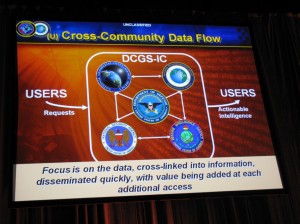
That’s true: Woodward, in fact, did rely on top-level leaking – including from George W. Bush himself. One of the most startling parts of his last book THE WAR WITHIN concerns the intelligence technologies used to capture and kill Abu Musab al-Zarqawi and other Al Qaeda leaders in Iraq in 2005 and 2006. In the book, Woodward argues that these technologies were the secret weapons that turned the Iraq War around for Bush.
They were “some of the most highly classified techniques and information in the US government,” he wrote. A Defense Intelligence Agency official who was a top aide at the time to General Stanley McChrystal, the former commander of the Joint Special Operations Command (JSOC), told Woodward that the high-tech operations were so effective they gave him “orgasms.” All Bush would say, when asked about them, was: “JSOC is awesome.” The White House asked Woodward not to publish any details because that “might lead to unraveling of state secrets.” This really blew Woodward’s mind.
In interviews on 60 Minutes, CNN, NBC and other networks in the days after the book was published, he repeatedly said that he’d stumbled on the greatest national security secret since World War II and the Manhattan Project. When he talked to a 4-star general about his findings, he told NBC’s Andrea Mitchell, “the blood literally drained from his face;” “he said ‘you cannot write about this.'” By not disclosing the information, Woodward acted like he was somehow saving the Republic.
Well, this really struck me as odd because Woodward’s information was so familiar to me.
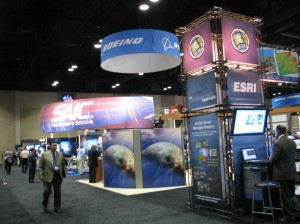
In fact, I’d learned about it as a lowly book writer and reporter two years before! Specifically, I learned about these Manhattan Project-like secrets at GEOINT, the annual conference and exhibition sponsored by the contractor-organized US Geospatial Intelligence Foundation. For intelligence players and aficionados, GEOINT is kind of the holy place where contractors and intelligence officials meet. So what was Woodward’s big secret?
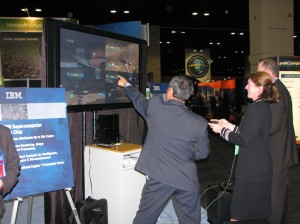
Well, as anybody writing about intelligence at the time was aware, he was talking about how terrorists were found, tracked and targeted by the NSA and the National Geospatial-Intelligence Agency, or NGA, which is responsible for imagery and mapping intelligence. Basically, these two agencies have learned how to create hybrid intelligence tools that – in official parlance – create “horizontal integration” between the two agencies, defined as “working together from start to finish, using NGA’s ‘eyes’ and NSA ‘ears’” (that’s actually from an NGA press release). They combine intercepts of cellphone calls with overhead imagery gathered by Predators and drones and use this data to track suspected terrorists in real time (for the latest on the NGA’s role in what it calls “intelligence fusion,” read this).
At the GEOINT meeting in 2006, the NGA director at the time, Adm. Robert B. Murrett, disclosed that it was through such technology that the U.S. military was able to locate and bomb the safe house where Zarqawi, the leader of al-Qaida in Iraq, was staying in June 2006. “Eventually, it all comes down to physical location,” he told reporters. When NSA and NGA data are combined, he added, “the multiplier effect is dramatic.” I knew this was big and wrote about it in an article for Salon – “America Under Surveillance” on Aug. 9, 2007 – a least one year before Woodward’s book came out. Details also appeared in my book, which was also released before Woodward’s.
So why did I learn this huge secret at GEOINT? Because the entities doing the work for the NSA and NGA were (and are) contractors, such as SAIC and Booz Allen. Contractors supply the tracking and surveillance technologies as well as many of the analysts who interpret the intelligence.
A few contractors even took public credit for their tracking and surveillance work on Al Qaeda: George Tenet actually gave an award to SAIC for the Zarqawi hit, an event well-publicized by the company. Another contractor to claim credit was CACI International, which gained notoriety for being the contractor most involved in the Abu Ghraib scandal. In a radio interview in 2006, CACI’s CEO bragged of its “forensic-type work” using information from “overhead imagery, communications satellites, and intercepts” to “determine connections among organizations and cells of people” and bragged that they had used these technologies to get Zarqawi.
Sound familiar?
This points to a broader issue about intelligence: the more it is privatized, the less secret it becomes.
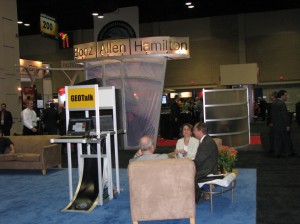
Just as I learned at GEOINT one of the most deeply held secrets of the war on terror, I was able to glean much that was on the Dark Side from corporate websites, interviews with contractors, SEC reports, internal and external corporate info, and conferences with investors and defense contractors. In fact I obtained so much information this way that my book is used at the Naval Intelligence Center for Information Dominance in Pensacola, Florida, to help budding intelligence analysts understand how much can be learned about intelligence from public sources.
Maybe, instead of prosecuting the Tom Drakes of the national security world, the government should go after the contractors.
But that doesn’t mean that contracted intelligence isn’t secret – it most certainly is. Most contracts are classified and there’s no requirement to disclose them. The use of earmarks in the conventional budget process, in which congressmen can secretly insert contractor projects without fear of any disclosure, allows agencies to further hide programs, including highly sensitive Special Access programs, from both congressional overseers and the public. And for the most part, these contractors toil on without recognition of the press and are thus hidden from the public (unless you know what you’re looking for: don’t forget to scroll through my 2010 posting, “The Corporate Intelligence Community: A Photo Exclusive.”)
Worse, Congress has refused to investigate. There’s been only one hearing on intelligence contractors that I can remember – a desultory event sponsored by the Senate Homeland Security Committee last year. And only a couple of concerned lawmakers in the House, Jan Shankowsky of Illinois and David Price of North Carolina – have bothered to ask serious questions about the implications of intelligence contracting. But without Congressional oversight, fraud waste and abuse – as exemplified by Trailblazer – continue. And the real actors in intelligence, the private sector, remain hidden from the American people.
So part of what I want to do here is introduce you to the ruling class of US intelligence. I’ll name three people – three of dozens. Two of them are probably familiar to you. But the first is not. Here they are (and there’s plenty more about them in my book):
RICHARD HAVER. If you read the first few pages of James Risen’s book on the CIA, STATE OF WAR, you’ll understand why. After many years in the darkest parts of naval intelligence, he worked for years at TRW, one of the first intelligence contractors whose work for the CIA was made famous in the Sean Penn movie “The Falcon and the Snowman.” It’s now a key unit of Northrop Grumman, where Haver, until recently, was vice president for intelligence (he’s now at a company called Passur Aerospace, which focuses on “integrated surveillance networks and databases, predictive analytics and business intelligence.”) Haver, who led the CIA investigation into the Aldrich Ames spying case, was for many years an intelligence adviser to both Dick Cheney and Donald Rumsfeld – in two administrations – and led the Cheney-Bush intelligence transition team in 2001. TRW & Northrop Grumman play key roles at the NSA and NGA and in the computerized drone war of today.
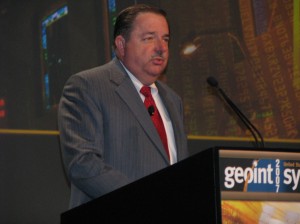
MIKE MCCONNELL – When he was nominated as Bush’s Director of National Intelligence in 2006 I wrote a profile in Salon hoping someone in the Senate would look into his role at Booz Allen Hamilton and all the programs it’s been involved in. McConnell, like Haver, started out in Naval intelligence, tracking target for US bombers in Vietnam and Cambodia. Later he was a military intelligence adviser to Colin Powell and Dick Cheney during the first Gulf War. Then, with Cheney’s assistance, he was named NSA director and served under President Clinton. After that he was hired by Booz Allen, where he ran the company’s extensive programs in military intelligence until Bush appointed him DNI. He ran the warrantless surveillance program and pushed through legislation to exonerate and provide immunity to the telecom providers and the contractors who’d collaborated with the NSA (and, as Jameel Jaffer reminded me, create an entirely new national system of warrantless wiretapping). And now he’s back at Booz, promoting cyberwarfare.
JOHN BRENNAN – As President Obama’s chief intelligence adviser, this man has revolved through the door and back again. Brennan is the former CIA Station Chief in Saudi Arabia and was once director of the CIA’s CounterTerrorism Center. Then he left the CIA and joined a company called The Analysis Corporation before moving on to the Obama administration. Remember the Christmas Day bomber in 2009? Remember Brennan almost going down on his knees apologizing to Obama? Why would an intel adviser do that? Well he had personal responsibility – TAC, his former company, built the database for the National CounterTerrorism Center that failed to track the Nigerian. CACI, by the way, maintains the database.
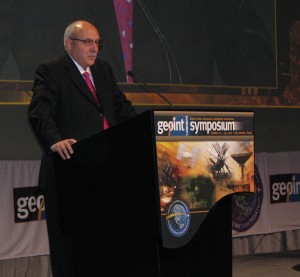
These men, when they’re wearing their corporate logos, make up the core of the private intelligence industry but should really be consider an essential part of the IC and subject to as much public exposure as high ranking government officials such as the DNI or the Secretary of Defense. Let me read a quote about McConnell that’s true of all these men. It’s from Ellen McCarthy, president of the Intelligence and National Security Alliance, another shadowy part of the IC (I have a lot about INSA in my book), speaking to Bloomberg:
“In many ways Admiral McConnell can be more influential in supporting the intelligence community now than when he was in office. He’s not constrained by the bureaucracy, and is viewed as a senior statesman operating in an advisory capacity.” That’s very telling.
So, to conclude, what we have here is a revolving door of the highest order. And, as Tom Drake will tell you based on his own experience as an NSA employee and a contractor, it’s all part of a massive transfer of wealth from government to business the likes of which we’ve never seen. As I revealed in SPIES FOR HIRE, 70 percent of the intelligence budget goes to contractors. You can do the math – if the intelligence budget is $100 billion, that’s $70 billion going straight to the private sector.
As you listen to our discussion tonight, keep in mind that everything we talk about has a private component. That includes covert operations, rendition, torture, illegal surveillance and wiretapping, targeted assassinations, drone wars: everything.
And here’s a plea to the other reporters in the room: without considering the private sector component, the concept of intelligence “community” is a misnomer. In reality, the IC is a joint venture, probably the most profitable secret business in the world. And I don’t think we’ve come close to grasping the full implications of these private companies sharing – and making money from – the nation’s most classified programs. For my part, I’m going to do all I can to expose this industry and its part in diminishing our rights as American citizens.
Tim Shorrock
New York City
April 4, 2012
All photos copyright Tim Shorrock.
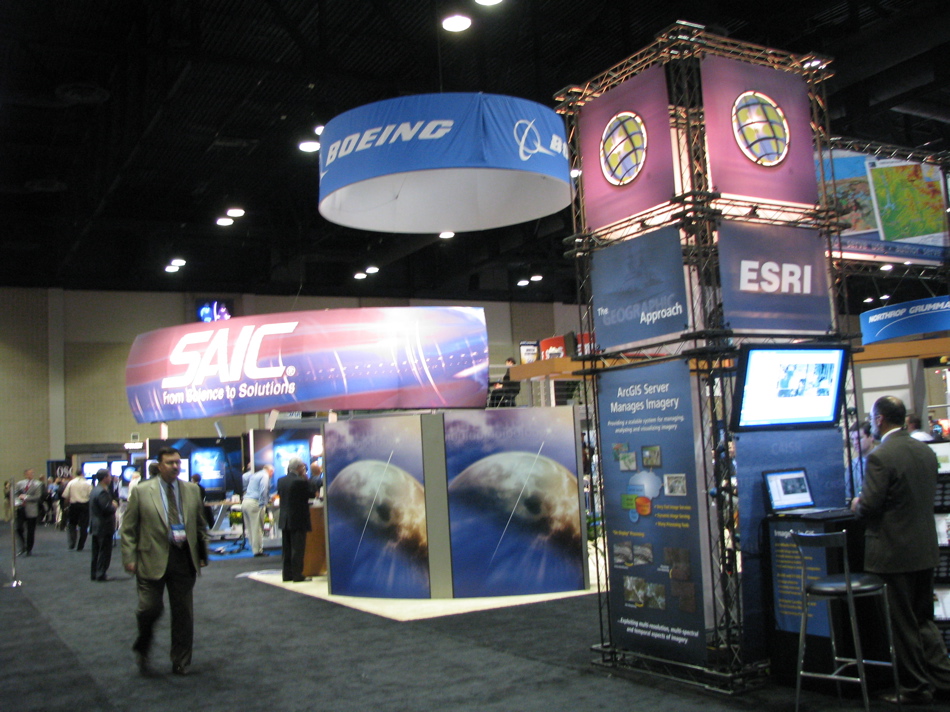
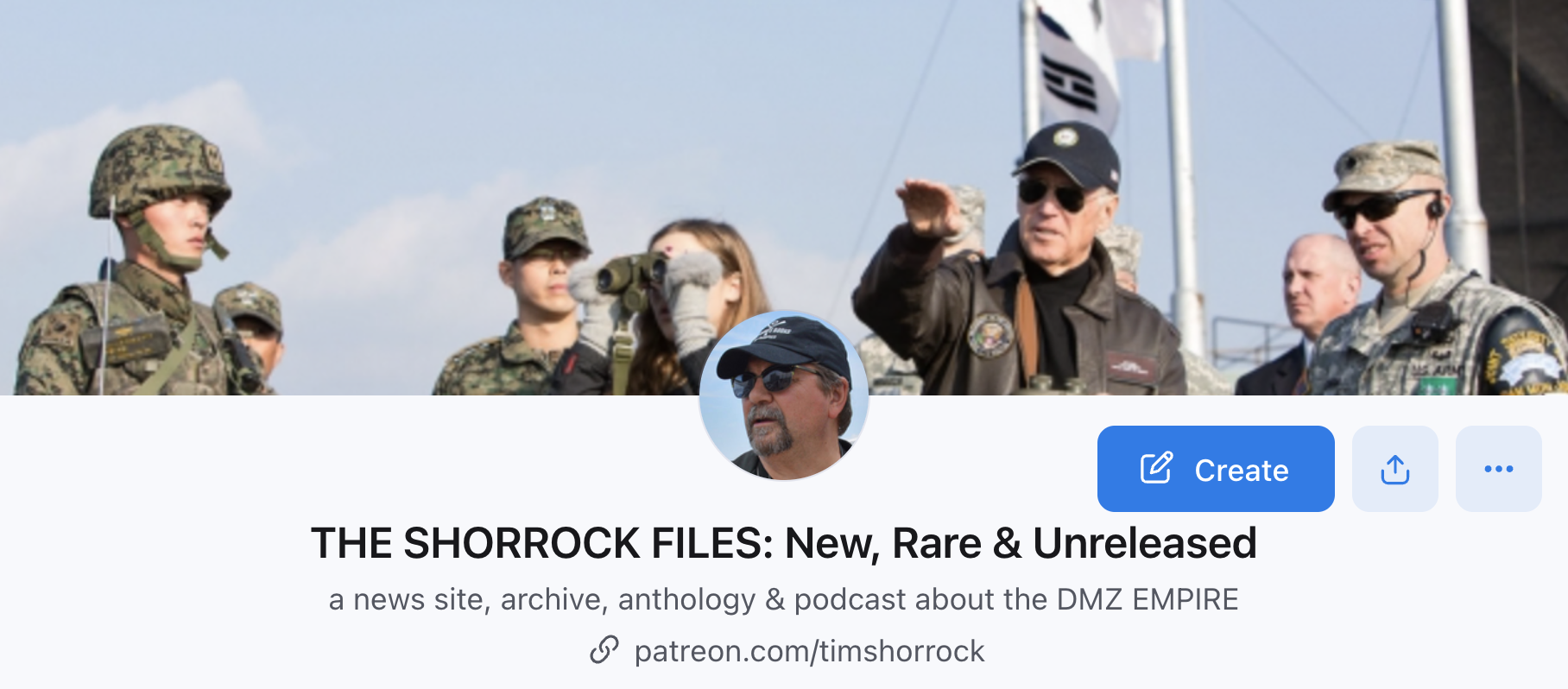
Excellent work.
And Thank You for your human dedication to a better world.
Above all hidden behind the intel front described here,
who, what, rules our hidden rulers. That is the question.
They don’t want it answered.
We must.